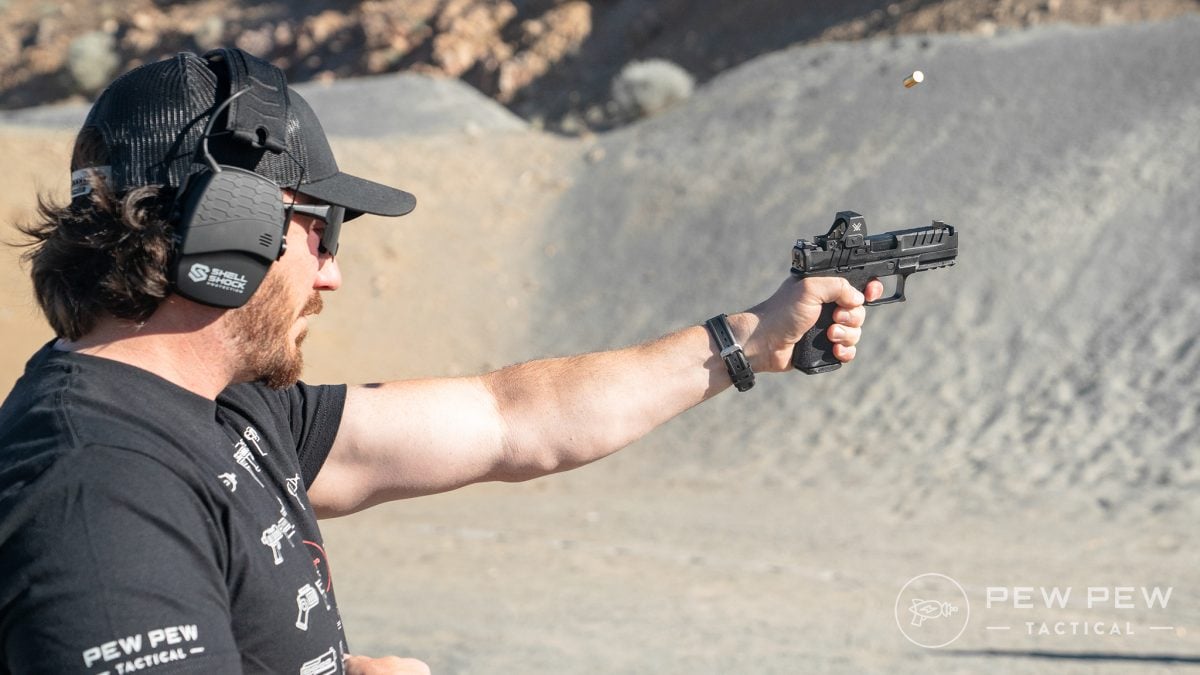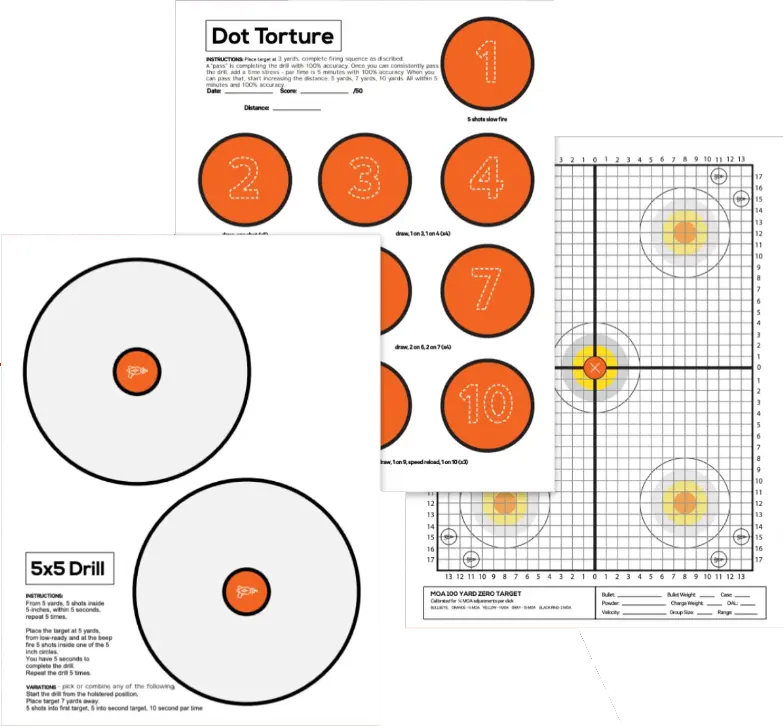Shooting a pistol looks so easy when the pros do it. Why is it so hard for the rest of us?
You can make huge improvements by dialing in your shooting stance.
There are a few different ways to go about this, and we’ll cover the most common shooting stances – Weaver, Chapman, and Isosceles – so you know what to do and when to do it. Then we’ll touch on a few bonus stances and techniques.
Let’s roll!
Table of Contents
Loading…
Shooting Stance 1: Weaver

Pros
- Mimics a natural athletic stance
- Decent recoil management
Cons
- Takes more effort to rotate to your non-dominant side
- Challenging for cross-eye-dominant shooters
The Weaver stance that Los Angeles County Sheriff Jack Weaver developed in the 1950s is old-school. But as is the case with revolvers and 1911s, that doesn’t mean it’s outdated.
While facing your target, take a step forward with your non-dominant foot. Shift your weight forward over the ball of this foot – think, “Nose over toes.”
This will somewhat blade your torso to the target and minimize your target area if you’re not wearing body armor.

Present the pistol by fully extending your dominant hand, then finish your grip by supporting it with your non-dominant hand. You’ll need to bend your non-dominant arm to make this happen.
Think about pushing with your shooting hand, and pulling with your support hand.
This stance is good for managing recoil, and it mimics a natural fighting stance. If you were to step into a boxing ring, you’d probably assume something pretty close to the Weaver position.
While the Weaver position maintains good situational awareness to your front and strong side, your non-dominant or support side will become a blind spot. If you do need to rotate to that side, it will take some effort.
Maneuvering is also a little challenging from this position, because we aren’t used to walking with our torso twisted to one side. You can still make it work; it just takes some practice.
Shooting Stance 2: Chapman

Pros
- Repeatable and easy to master
- Great for recoil management
Cons
- Doesn’t allow easy movement or rotation
- Gets uncomfortable for your neck pretty quickly
The Chapman stance created by competitive shooter Ray Chapman is also called the modified Weaver stance, and that will be our starting position.
This time, lock out that dominant arm and press your cheek into your bicep just like you’re using a rifle stock. Your dominant eye should fall right in line with your sights. If you’re cross eye-dominant, try turning your nose slightly outward over your arm to achieve a good sight picture.
Since you have one arm fully extended and more points of contact, this stance is extremely easy to implement consistently. It’s also fantastic for managing recoil.

Like the Weaver stance, this one minimizes your target area if you’re not wearing body armor. If you are, it turns the plates sideways and diminishes their ability to protect you.
Once you get used to it, shooting accurately with the Chapman stance is pretty easy. That comes at a price, though.
Tucking your face into your arm is lousy for situational awareness on both sides. If you need to move, you’ll have to completely break down this stance, get where you need to go, and build it from scratch again.
If you’re taking cover and aiming at a known, stationary target, this is a great way to make an accurate shot with a handgun. It’s not great for more dynamic environments.
Shooting Stance 3: Isosceles

Pros
- Stable, balanced, and intuitive
- Maximizes body armor surface area
Cons
- Presents a large target area if you aren’t wearing body armor
- Feels a little stiff if you have to shoot and move
The Isosceles stance really took off popularity when body armor became common in the military and law enforcement, because it presents the most favorable surface area of armor in relation to exposed body parts.
To use the isosceles position, start by facing your target and standing normally.
Spread your feet shoulder width apart or wider, and put a slight bend in your knees. Allow your hips to move to the rear and your shoulders to push forward. Extend your arms equally (like an isosceles triangle) and present the pistol. You should feel a slight forward bias in your weight, with pressure on the balls of your feet.

When you fire, any unmanaged energy will actually nudge your weight into a more neutral position rather than knocking you backward.
This stance is great for shoot-and-move situations. We naturally square up to whatever we’re looking at, so you’re partly there automatically. The symmetrical arm position makes it easy to rotate to either side like a turret.
The isosceles position has a major drawback. If you aren’t wearing body armor, you end up maximizing your own target area – the exact opposite of what you want to do.
I’ve also seen new shooters get off-balance with this position since both feet are on the same plane. If you stand too upright or lean back at all, even a mild recoil impulse will push your weight onto your heels.
Bonus Shooting Stances
You have more than three options when it comes to shooting a pistol, so let’s briefly cover some of the other stances you might encounter.
One-Handed

Pros
- Useful if one hand is injured or otherwise occupied
- Great for fine-tuning your technique
Cons
- Compromises stability
- Makes it difficult to manage recoil effectively
Think one-handed shooting is just for Hollywood cowboys and gangsters? No way; this is a perfectly viable way to shoot a pistol, and you need to practice it.
Practically speaking, one-handed shooting is useful if you sustain an arm injury, need to carry something, or need to use a door handle.
It’s also a brutally honest way to expose flaws in your grip. After humbling yourself and improving your technique, you’ll probably find two-handed shooting much, much easier.
I once spent several weeks doing nothing but one-handed shooting in preparation for a particular match, and going back to both hands afterward felt like unlocking easy mode.

The drawbacks of this technique are fairly obvious. You have to give up a lot in terms of grip strength and stability, so it takes a lot of practice to get close to what you could accomplish with two hands.
Center Axis Relock

Pros
- Very effective in confined spaces
- Allows excellent freedom of movement
Cons
- Not ideal for accuracy at distance
- Better for quick transitions than a full-time stance
Shooting guru Paul Castle created the center axis relock technique, but it’s probably best known for the modified center axis relock that appears frequently in the John Wick franchise.
This technique is all about close-quarters defense. The compressed posture makes it easy to maneuver in vehicles and other tight spaces without breaking the sighting line from your eye to the sights to the target.
You also have the ability to strike with the pistol, throw an elbow, or punch out into another shooting stance extremely easily from this position.
And it’s wildly entertaining.
Keep this one in your toolkit as a transitional posture. It’s not meant for accuracy beyond a few yards, and the skills it requires don’t necessarily transfer well to other types of shooting.
There’s more to learn, so check out our deep dive into center axis relock.
Training With Multiple Shooting Stances
All of these stances are useful, and none of them are perfect. I recommend training with all of them.

If you ever need to defend yourself with a handgun, it probably won’t happen on a flat range with designated target areas and firing lines. The more skills you have to work with, the better off you’ll be.
It’s a lot easier to modify one of these stances to suit the present threat than it is to cook up something on our own in the heat of the moment.
Imagine being boxed in your vehicle by multiple threats at various distances.

A proper response might involve using the center axis relock to fire through your driver-side window, punching out to a modified isosceles position once the glass breaks, and stepping out of the vehicle to engage a more distant target with the Weaver or Chapman stance before making a run for it.
That scenario is pretty unlikely, but I’d regret being a one-stance guy if it were to happen to me.
Additional Resources to Improve Your Technique
There’s more to great pistol shooting than your stance, and we’re here to help! Check out these other guides to level up your shooting.
- The 4 Firearm Safety Rules
- How to Properly Shoot a Handgun or Pistol
- How to Shoot a Pistol Accurately
- How to Grip a Pistol
- Trigger Pull and Follow Through
- Safe and Effective Dry-Fire Training at Home
- 9 Best Shooting Drills
Verdict: The Very Best Shooting Stance
As with many things, I have to fall back on, “It depends.” There is no perfect shooting stance for every situation.

Are you shooting for maximum precision at distance, or maximum speed up close? Are you working in confined spaces? Do you even have the option to use both hands? How you answer those questions at any given moment will affect which shooting stance is most useful.
Your best bet is to train with all of them. Don’t make one shooting stance your entire personality (that goes for any technique or piece of gear, by the way). Equip yourself with as many tools as possible, and know when to use each one.
Look at you; you’re turning into a pro already.

What’s your favorite shooting stance and why? Let us know in the comments. Just getting started? Check out our Gun Buddy Online Pistol Course to go from gun noob to gun slinger!
Latest Updates
November 2025: Complete overhaul with new information and supporting content.









29 Leave a Reply
Is that the Carson City, NV Range?
We have an eagle-eyed local on our hands!
Please try central axis relock for the meme and john wick fanboys
aaaaa
Thank you fir the article; spot on
i use none of these stances, as i fire with one hand. the 148grain 357 rounds don't put me on my arse or whatever because i stand right foot at 1 o'clock left foot at 10.
Excellent article with great photos.
One of those discussions that no one will ever agree on.... For my 2 cents worth... I spent 10 years in the army and all combat was with an FAL (7.62 NATO) or an MAG... If you did not have a weaver type stance you will be sitting on your arse... From hi powered rifles I started on the Colt 1911... Again - if you are using a 44, 357 or a 45 - you need to be using the weaver or Chapman stance... Just a thought...
You've obviously never been to gunsite the blading thing was never taught..law enforcement started that
Oh so you're cross eye dom
Very good article comparing the three stances. I was taught by Ray Chapman at his practical shooting school in the 80's and adopted the Modifies Weaver Stance from that time until today. I too demonstrate all three stances to my students, teaching the pros,and cons of each. Then, I allow my students to choose the one most natural to them. Thank you for your articles and instruction. My students have Pew Pew listed as one of their online resources.
One overlooked benefit to the Weaver and Chapman stance is that it is much more natural to shoot from cover -i.e., behind a wall - as long as we are able to use our dominant hand. One disadvantage of these stances is that we become very dominant-hand oriented, and it's harder to switch to our non-dominant hand if we need to.
Tim, I completely feel your frustration about classes. After taking my initial training at Smith&Wesson, then being told I had to change all that at American Small Arms Academy, then having yet another experience at FPF training, I have learned to ask in advance if anyone is going to have a problem with my Chapman stance, Israeli grip or Viridian laser, BEFORE I plunk down another $600 and have somebody tell me I'm "doing it all wrong" again.
Absolutely agree that Weaver/Chapman stance is superior to shoot from cover or concealment. Only eye and a very small portion of head plus shoulder and shooting arm is exposed. Practice shoot reversed from other side. 35 years ago, I set up several local IDPA/IPSC Matches with a several second penalty to not use cover effectively e.g. shooting right handed using left cover. Some complained, I was match director and Chief Range Officer for match.
I was over ruled at State Match.
I was parachute infantry in RVN, 173rd ABN BDE LRRP
Don't use the older military 'Teacup' grip... really... when milliseconds count this may be the only grip you'll have time do. Unless of course you tell the bad guy to wait while you make sure your right thumb is above the left and your fingers are positioned so the slide doesn't rip five layers of skin and knuckle. Truth be told, whatever technique allows you to put at least 3 rounds in a tight group, where you aimed, in the least amount of time is what's important. Oh BTW... as a former Marine... if I'm standing in one place longer than it takes to fire 3 rounds then I'm in one place too long.
Thanks for the article Eric. I just completed a conceal carry class here in TN and the instructor required that we all shoot from the isosceles stance. I've been shooting in a Chapman stance for 15+ years and switching was so uncomfortable to me. Between that and some minor differences she forced in the grip, I'm lucky I passed the test (and this was at 7 yards!). I went to the range the next day, assumed my normal stance/grip and was shooting 3-4" groups at 15 yards. I think a part of what feels so off for me is the fact that I do muay thai kickboxing and am used to staggered feet and a more upright position. Anyway, thanks for pointing out that there isn't necessarily a "right:" stance, it's what works for you!
Col Applegate taught the Army in the 40s and from his book to shoot in his kill or get killed. After soldiers were taught the basics he went into practical shooting from three positions. The prone which he used from 50 yrds because it was the most stable, Next was kneeling from about 25 yrds and last standing one handed square to the target and it was full arm extended point shooting. He would pivot from left to right and not swing the body or shooting arm. that was from 15 yrds or less.
what about Center Axis Relock (CAR)?
We looked at CAR in another article :)
Hey i'm 20 y/o and been getting into guns quite a bit. Your articles have greatly expanded my knowlage on guns and ammunition. I actually am joing the Air Force soon just waiting on a couple of waivers. Anyway despite growing up in a very conservative county and with extended family all in East Texas and Fortworth i've had a lot of exposure to firearms but never really shot any myself. So these articles are slowly heloing me move past my noob status and i'm actually having fun learning all of the technicalities. I won't purchase a firearm before being shipped out, because i don't know enough to teach myself how to shoot so i'll leave that up to the combat arms trainers. Anyway thanks for all the info!
Eric, Great article and time have changed on what is the correct way to fire a weapon.
As far as tea cupping or one handed fire the old WW2 vets we deadly accurate with these types of fire because of the training. Case in point was my father. I could beat him using the rifle because his eyes were older but he could still take me at 5 yards with a pistol up to his death. He was taught the tea cup and one handed shooting but he preferred the on handed technique.
Again great article. I work best with the Chapman or Fighting Stance along with one handed.
Great point Ray! And thanks for sharing that story about your father.
Excellent and obviously very useful information. THANKS!
You're welcome!!
Didnt see a mention of the fighting stance (aka modified isosceles etc etc) It's taking out the cons of both the isosceles and weaver stance, developed by special forces (i think).
Arms like isosceles but feet like weaver (in case you don't know what im talking about).
The grip shown here looks like the slide would destroy your hand. I don't use a teacup but I suppose I use a modified teacup. Thumb forward the right hand in that pic just seems like the thumb is out of position, no?
Hey Nelson, if you mean the 1911 in the last pic it might be the angle. I'm resting the thumb on the thumb safety and I haven't had slide bite yet.
For everyone who doesn't understand what was said, many guns have parts that can slice flesh and break bones if held improperly. I have a few scars. If you aren't fully confident, ask about how a particular gun should be held when you buy or borrow it.
Great Site!!! Answers all the questions, I want to know.
Can you talk about internal safeties such as for the S&W M&P 9mm or Glock pistols and how can I gain confidence in carrying a gun with this type of safety system.
Hi Dan, good idea for a future article on internal safeties. For carrying I'd suggest something that covers the trigger guard and for yourself, check out my trigger discipline article (http://www.pewpewtactical.com/trigger-discipline-control-guide/). The best safety is yourself!